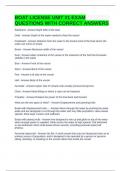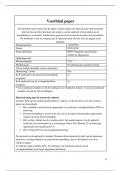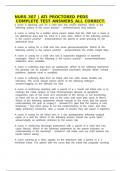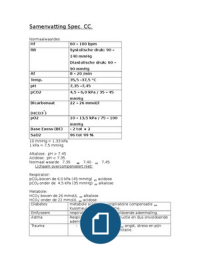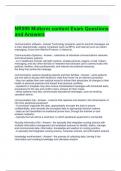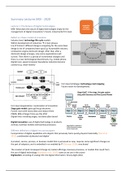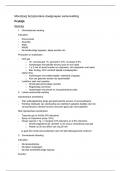BOAT LICENSE UNIT #1 EXAM
QUESTIONS WITH CORRECT ANSWERS
Starboard - Answer-Right Side of the boat
Draft - Answer-Depth of the water needed to float the vessel
Freeboard - Answer-Distance from the water to the lowest point of the boat where the
water can come on board
Beam - Answer-Maximum width of the vessel
Keel - Answer-Main centerline of the vessel or the extension of the hull that increases
stability in the water
Bow - Answer-Front of the vessel
Stern - Answer-Back of the vessel
Port - Answer-Left side of the vessel
Hull - Answer-Body of the vessel
Gunwale - Answer-Upper side of vessels side usually pronounced gunnel
Cleat - Answer-Metal fitting on which a rope can be fastened
Propeller - Answer-Rotates the power of the boat back and forward
What are the two types of hulls? - Answer-Displacement and planning hulls
Boats with displacement hulls... - Answer-Move through the water by pushing the water
aside and are designed to cut through the water with very little propulsion. Have slower
speeds. Most large cruisers and sailboats.
Boats with planing hulls - Answer-Are designed to rise up and glide on top of the water
when enough power is supplied. Glide across the water at high speeds. Flat bottomed
or vee bottomed. Most small power-driven vessels, including personal watercraft
(PWCs)
Personal watercraft - Answer-Jet Ski. A small vessel that uses an inboard jet drive as its
primary source of propulsion, and is designed to be operated by a person or persons
sitting, standing, or kneeling on the vessel rather than inside the vessel
, Different Modes of Planing Hulls - Answer-Displacement Mode:Very slow speed. Cuts
through the water like displacement hulls
Plowing Mode: As speed increases, bow rises, reducing operators vision, throwing large
wake, Avoid maintaining this mode.
Planing Mode:Hull glides across the water. Very high speed.
Flat Bottom Hull - Answer-Shallow draft, good for fishing in lakes or rivers one bad thing
is it rides roughly in choppy waters
Deep Vee Hull - Answer-Gives a smoother ride than flat bottom hull in rough water one
disadvantage is takes more power to move at same speed as flat bottom. May roll or
bank in sharp turns
Round Bottom Hull - Answer-Moves easily through water at slow speeds. Bad thing: has
a tendency to roll unless it has a deep keel or stabilizers
Multi-Hull - Answer-Has greater stability because of its wide beam. Disadvantage:
Needs a large area while turning
Length overall is measured from... - Answer-The tip of the bow to the stern of the vessel
in a straight line excluding attachments
Rudder - Answer-Steering device, usually a vertical blade attached to a post at, or near,
the stern of the boat
Outboard - Answer-Portable, self-contained package of an engine, gear case, and
propeller that is attached to the transom of a boat. Most in four stroke design. man still
have 2 stroke designs.
Transom - Answer-Vertical surface at the back of the hull
Steering of outboard boats - Answer-Is controlled by a tiller or steering wheel that
swivels the entire engine to direct propeller thrust.
Tiller - Answer-Lever used to turn the rudder to steer the boat
An inboard is a - Answer-Four-stroke automotive engine adapted for marine use.
Inboard engines are mounted inside the hull's midsection or in front of the transom.
The engine turns a drive shaft that runs through the bottom of the hull and is attached to
a propeller at the other end.
Many PWCS have what engines and what do they do? And what is the second kind? -
Answer-Two-stroke inboard engines that burn oil as a lubricant along with the fuel. New-
QUESTIONS WITH CORRECT ANSWERS
Starboard - Answer-Right Side of the boat
Draft - Answer-Depth of the water needed to float the vessel
Freeboard - Answer-Distance from the water to the lowest point of the boat where the
water can come on board
Beam - Answer-Maximum width of the vessel
Keel - Answer-Main centerline of the vessel or the extension of the hull that increases
stability in the water
Bow - Answer-Front of the vessel
Stern - Answer-Back of the vessel
Port - Answer-Left side of the vessel
Hull - Answer-Body of the vessel
Gunwale - Answer-Upper side of vessels side usually pronounced gunnel
Cleat - Answer-Metal fitting on which a rope can be fastened
Propeller - Answer-Rotates the power of the boat back and forward
What are the two types of hulls? - Answer-Displacement and planning hulls
Boats with displacement hulls... - Answer-Move through the water by pushing the water
aside and are designed to cut through the water with very little propulsion. Have slower
speeds. Most large cruisers and sailboats.
Boats with planing hulls - Answer-Are designed to rise up and glide on top of the water
when enough power is supplied. Glide across the water at high speeds. Flat bottomed
or vee bottomed. Most small power-driven vessels, including personal watercraft
(PWCs)
Personal watercraft - Answer-Jet Ski. A small vessel that uses an inboard jet drive as its
primary source of propulsion, and is designed to be operated by a person or persons
sitting, standing, or kneeling on the vessel rather than inside the vessel
, Different Modes of Planing Hulls - Answer-Displacement Mode:Very slow speed. Cuts
through the water like displacement hulls
Plowing Mode: As speed increases, bow rises, reducing operators vision, throwing large
wake, Avoid maintaining this mode.
Planing Mode:Hull glides across the water. Very high speed.
Flat Bottom Hull - Answer-Shallow draft, good for fishing in lakes or rivers one bad thing
is it rides roughly in choppy waters
Deep Vee Hull - Answer-Gives a smoother ride than flat bottom hull in rough water one
disadvantage is takes more power to move at same speed as flat bottom. May roll or
bank in sharp turns
Round Bottom Hull - Answer-Moves easily through water at slow speeds. Bad thing: has
a tendency to roll unless it has a deep keel or stabilizers
Multi-Hull - Answer-Has greater stability because of its wide beam. Disadvantage:
Needs a large area while turning
Length overall is measured from... - Answer-The tip of the bow to the stern of the vessel
in a straight line excluding attachments
Rudder - Answer-Steering device, usually a vertical blade attached to a post at, or near,
the stern of the boat
Outboard - Answer-Portable, self-contained package of an engine, gear case, and
propeller that is attached to the transom of a boat. Most in four stroke design. man still
have 2 stroke designs.
Transom - Answer-Vertical surface at the back of the hull
Steering of outboard boats - Answer-Is controlled by a tiller or steering wheel that
swivels the entire engine to direct propeller thrust.
Tiller - Answer-Lever used to turn the rudder to steer the boat
An inboard is a - Answer-Four-stroke automotive engine adapted for marine use.
Inboard engines are mounted inside the hull's midsection or in front of the transom.
The engine turns a drive shaft that runs through the bottom of the hull and is attached to
a propeller at the other end.
Many PWCS have what engines and what do they do? And what is the second kind? -
Answer-Two-stroke inboard engines that burn oil as a lubricant along with the fuel. New-

